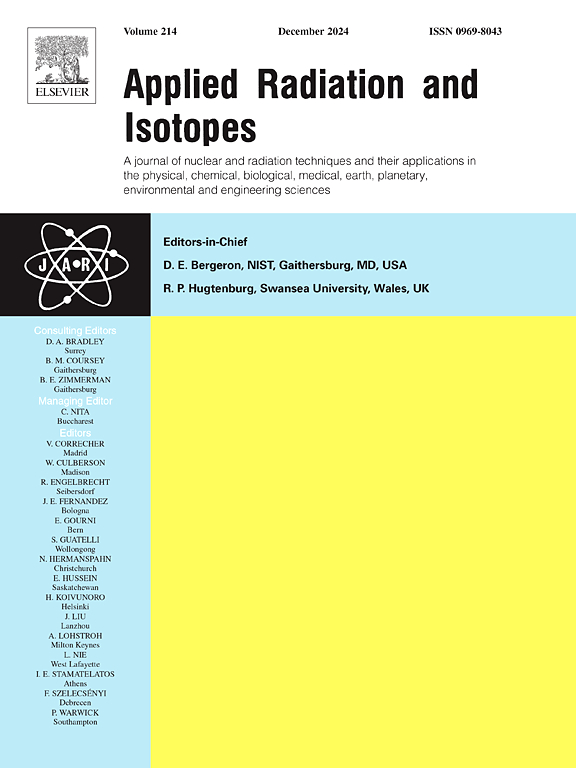探索暴露于伽马射线的大豆基因型的不同辐射敏感性并确定诱导诱变的最佳剂量
IF 1.6
3区 工程技术
Q3 CHEMISTRY, INORGANIC & NUCLEAR
引用次数: 0
摘要
电离辐射在突变育种中是一个强有力的工具,使植物育种家能够诱导遗传变异并培育出具有理想性状的新作物品种。本研究研究了γ辐射(一种强效电离辐射)对4个大豆品种的影响。这些品种暴露在0 Gy(对照)至600 Gy的伽马射线剂量范围内。目的是评估不同辐射剂量对大豆基因型的影响,并根据致死剂量(LD50)和生长减少(GR50)研究确定诱导诱变的最佳剂量。结果显示,在所有基因型中,增加γ剂量与幼苗生长呈负相关。这从茎长、成活率、株高、发芽率和干重的减少可以看出。有趣的是,根长表现出辐射激效,在低剂量下表现出刺激。幼苗性状中,茎长和成活率对γ辐射最敏感。该研究发现了辐射敏感性的基因型特异性差异,在测试的基因型中,LD50值在313至345 Gy之间,GR50值在295至335 Gy之间。值得注意的是,JS 20-98是最敏感的基因型,而MACS 13是最耐受性的基因型。这些发现强调了在大规模诱变计划之前标准化每种基因型的最佳辐射剂量的必要性,以确保所需突变体的有效产生。该研究强调了辐射剂量与基因型特异性反应之间的复杂关系,为开发有效的突变育种策略提供了重要见解。该研究为在大豆改良项目中利用伽马辐射提供了坚实的基础。本文章由计算机程序翻译,如有差异,请以英文原文为准。
Exploring differential radiosensitivity in soybean genotypes exposed to gamma rays and determining optimal doses for induced mutagenesis
Ionizing radiation serves as a powerful tool in mutation breeding, enabling plant breeders to induce genetic variability and develop novel crop varieties with desirable traits. This study investigated the effects of gamma radiation, a potent form of ionizing radiation, on four soybean cultivars. The cultivars were exposed to gamma ray doses ranging from 0 Gy (control) to 600 Gy. The objective was to assess the impact of varying radiation doses on soybean genotypes and determine the optimal dose for induced mutagenesis based on lethal dose (LD50) and growth reduction (GR50) studies. Results revealed a negative correlation between increasing gamma doses and seedling growth across all genotypes. This was evident from reductions in shoot length, survival percentage, plant height, germination percentage, and dry weight. Interestingly, root length exhibited radiation hormesis, showing stimulation at low doses. Among seedling traits, shoot length and survival percentage were identified as the most sensitive to gamma radiation. The study found genotype-specific differences in radiosensitivity, with LD50 values ranging from 313 to 345 Gy and GR50 values from 295 to 335 Gy across the tested genotypes. Notably, JS 20–98 emerged as the most sensitive genotype, while MACS 13 was the most tolerant. These findings underscore the necessity of standardizing optimal radiation doses for each genotype prior to large-scale mutagenesis programs to ensure the efficient generation of desired mutants. This research highlights the intricate relationship between radiation dose and genotype-specific responses, offering critical insights for developing effective mutation breeding strategies. The study provides a robust foundation for utilizing gamma irradiation in soybean improvement programs.
求助全文
通过发布文献求助,成功后即可免费获取论文全文。
去求助
来源期刊

Applied Radiation and Isotopes
工程技术-核科学技术
CiteScore
3.00
自引率
12.50%
发文量
406
审稿时长
13.5 months
期刊介绍:
Applied Radiation and Isotopes provides a high quality medium for the publication of substantial, original and scientific and technological papers on the development and peaceful application of nuclear, radiation and radionuclide techniques in chemistry, physics, biochemistry, biology, medicine, security, engineering and in the earth, planetary and environmental sciences, all including dosimetry. Nuclear techniques are defined in the broadest sense and both experimental and theoretical papers are welcome. They include the development and use of α- and β-particles, X-rays and γ-rays, neutrons and other nuclear particles and radiations from all sources, including radionuclides, synchrotron sources, cyclotrons and reactors and from the natural environment.
The journal aims to publish papers with significance to an international audience, containing substantial novelty and scientific impact. The Editors reserve the rights to reject, with or without external review, papers that do not meet these criteria.
Papers dealing with radiation processing, i.e., where radiation is used to bring about a biological, chemical or physical change in a material, should be directed to our sister journal Radiation Physics and Chemistry.
 求助内容:
求助内容: 应助结果提醒方式:
应助结果提醒方式:


